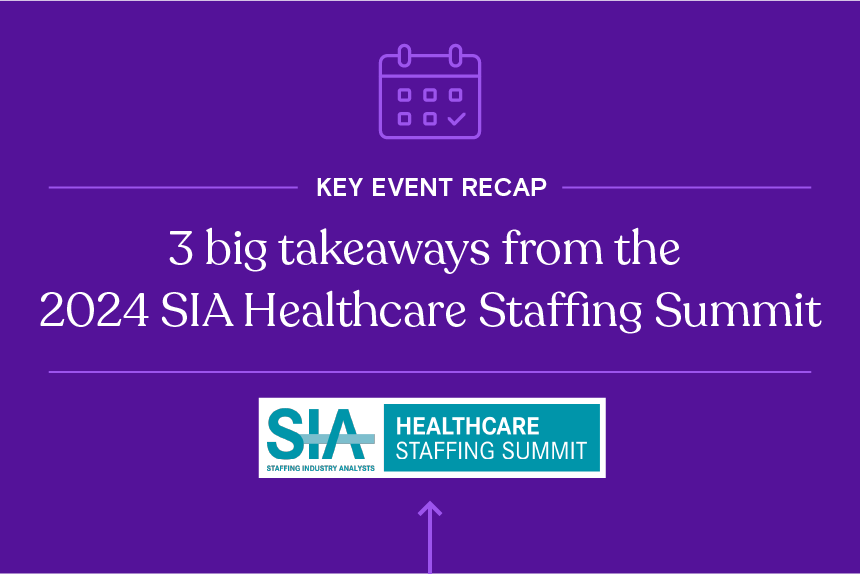There’s good and bad news ahead for the healthcare staffing industry. First, the bad: Healthcare’s staffing problems aren’t likely to go away anytime soon. A rapidly aging population is raising demand for care across the board, and chronic shortages, ongoing burnout, and a workforce that’s also growing older isn’t making matters better.
Now for the good news. The industry’s leaders are finding ways to address these pressing issues with innovative technology, alternative hiring strategies, and renewed focus on burnout reduction.
The 2024 SIA Healthcare Staffing Summit brought these leaders and experts to Arlington, Texas last week to tackle these challenges head-on, exploring and discussing strategies to build a more resilient and adaptable workforce. In this blog, we’ll dive into the standout themes and discussions from the summit, examining the insights shared and the path forward for healthcare staffing.
Technological innovations support both sides of the staffing equation
A variety of technologies have emerged as vital tools to support both clinical teams and the staffing professionals who recruit them. Digital recruitment platforms, telehealth and remote work innovations, as well as AI-driven tools are helping healthcare organizations navigate an increasingly complex hiring landscape and boost operational efficiency.
Among the most promising advancements discussed at the 2024 SIA Healthcare Staffing Summit is the use of artificial intelligence (AI) in recruitment and screening platforms. When used well, these tools can streamline the entire hiring process, from vetting to onboarding, helping staffing teams more efficiently source and equip qualified candidates with the skills they need. For instance, AI can significantly cut both the time, administrative burden, and error rate associated with medical credentialing, normally a 60- to 90-day process.
AI can also help overcome bias in the staffing process and automate repetitive tasks, reducing time to hire and getting critical positions filled with the most suitable talent. However, it’s critical that the developers of these platforms (and the teams that rely on them) be mindful of potential biases within the tools themselves to avoid filtering out highly qualified candidates.
Telehealth is another game-changing technology in the healthcare staffing world. We’ve written before how telehealth can take some of the pressure off overburdened care teams and add flexibility to their work arrangements. With nearly half of care workers reporting burnout, any relief is a win. However, this change has also introduced new staffing needs, with specialized hard and soft skills necessary to support virtual care models.
Predictive analytics and AI are making it easier to plan around these and other workforce planning challenges by providing insights into staffing needs and performance. These tools help organizations anticipate future demands based on workforce demographics and trends, allocate resources more effectively, and improve staff utilization.
As healthcare staffing—and the rest of the industry—become increasingly data driven, predictive analytics and AI will be necessary to create a resilient, responsive, and commercially competitive workforce that can adapt to the constantly evolving healthcare landscape.
New approaches are necessary to attract and retain high-quality staff
The COVID-19 pandemic saw roughly 20% of healthcare professionals leave the workforce, and those who remain continue to face intense pressures at work. At the 2024 SIA Healthcare Staffing Summit, industry leaders discussed strategies to improve talent acquisition, retention, and employee well-being.
For many healthcare organizations, tried-and-true approaches remain useful: Competitive compensation, enhanced benefits, and clear pathways for career advancement are attractive incentives in any field and help workers feel valued.
Supporting employees’ well-being is a slightly newer concept that can be trickier to handle. After all, how do you encourage an employee to get the care they need outside of work? The summit focused on initiatives to improve mental health specifically—on-staff counselors, employee assistance programs, and creating opportunities for frank and open discussions about workload and burnout can provide outlets for staff concerns and encourage healthy stress management at home.
As the healthcare staffing market is poised to reach $80 billion by 2030, competition is only getting more fierce, and some teams will need to look further afield to find the right staff.
Certain positions, like telehealth nurses and administrative personnel, can be hired offshore at competitive rates, boosting an organization’s bottom line and expanding their talent pool considerably.
In other cases, travel, per-diem, and locum tenens staffing will continue to be necessary to fill the gaps. Around 85% of healthcare facilities say they already rely on locum tenens staffing, and travel nursing now represents nearly a third of the healthcare staffing market.
The right relationships matter more than ever
While healthcare staff are in demand across the board, we’re beginning to see some trends in exactly who’s needed where. For instance, demand for travel and per diem nursing has slowly dropped in the years since the pandemic began, along with their billing rates. Agencies focusing on this sector may need to expand their scope and look for partners in more niche markets like allied health and community clinics.
Productive partnerships were a top theme of the 2024 SIA Healthcare Staffing Summit. Of course, providers can partner with staffing agencies to maximize the quality of available talent and keep current employees happy. But deeper collaborations between staffing agencies, healthcare organizations, and technology providers can help all stakeholders pool their resources, share best practices, and implement holistic, efficiently scaling solutions that benefit workers and patients alike within their unique markets.
Whether you’re a healthcare provider in need of staff, a staffing professional looking to connect talent with a suitable role, or a technology developer interested in supporting the staffing process, understanding the needs of a prospective partner—and knowing who best to discuss those needs with—can help you build a business relationship that benefits everyone involved.
Definitive Healthcare products and solutions give your entire organization access to the predictive analytics you need to identify the certifications, technologies, and therapy focuses needed across your market or within specific facilities and organizations. And if you want to get ahead in the soon-to-be booming long-term care market, our LongTermCareView product delivers insights on the facilities, providers, procedures, and diagnoses that matter most.
Sound useful? Sign up for a free trial today and see how we can help you navigate the complex healthcare staffing landscape.





